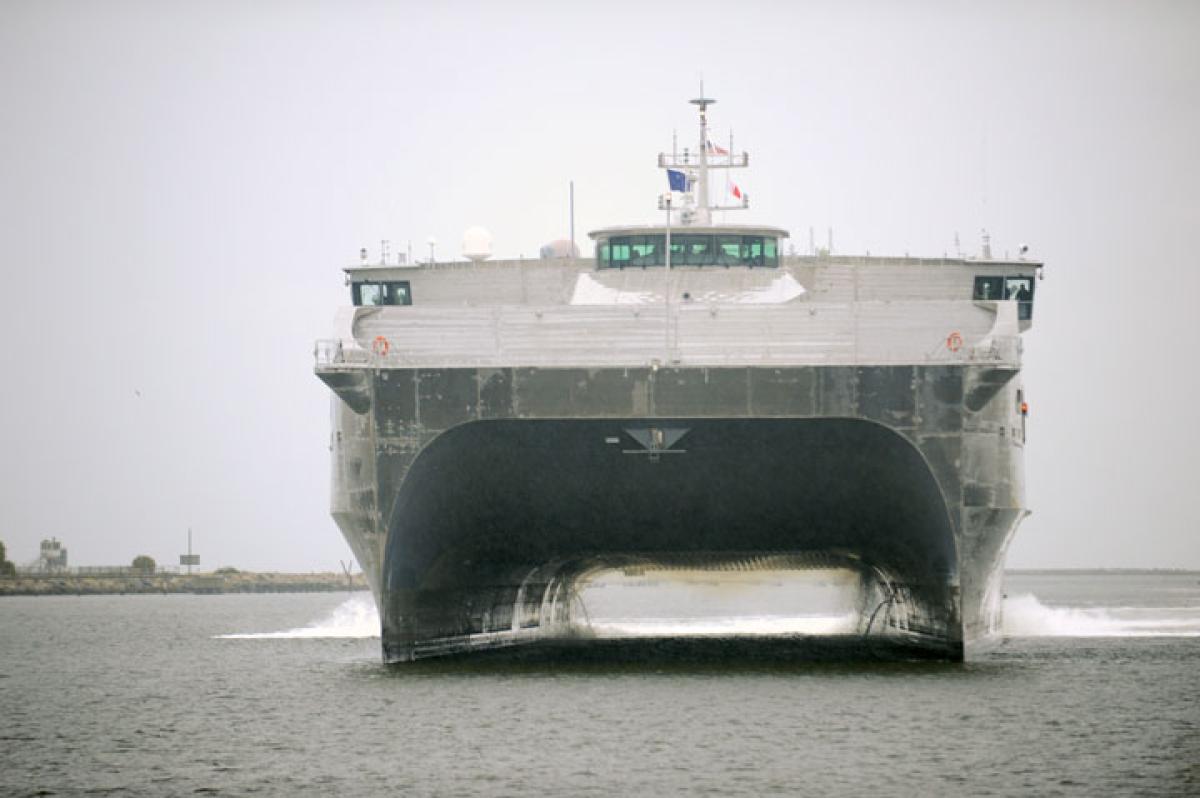The joint high-speed vessel Spearhead (JHSV-1) departed the Mobile, Alabama, shipyard of builder Austal USA in late January for her homeport of Little Creek, Virginia, following Navy acceptance of the ship in early December. The Spearhead, intended as a fast intra-theater transport for personnel, vehicles, and equipment, is set to commence a series of operational tests and sea trials prior to deploying to the Fleet later this year.
The commercial design for the 338-foot, 2,500-ton Spearhead is derived from Austal’s work in building fast craft for naval operations worldwide.
In a related January development, the Military Sealift Command renewed for six months a charter agreement with Austal Ltd. of Henderson, Australia, for the high-speed, 330-foot WestPac Express, which has provided fast transport for Marine Corps units in the Pacific since 2002, when it was employed for Exercise Cobra Gold.
The JHSV program consolidates the Army’s Theater Support Vessel and the Navy’s High Speed Connector, exploiting the design commonality of both programs. The Army chose the name Spearhead for the first of five JHSVs that the Army planned to build before the two services signed a memorandum of agreement in May 2011 transferring management of the program to the Navy. Nine more ships to be built will be named after U.S. counties.
The Navy says that the JHSVs will be built to American Bureau of Shipping standards for high-speed naval craft. No new technology is being developed for the program. The Navy awarded Austal USA a contract potentially worth $1.6 billion for construction of the Spearhead, with options for the nine additional ships, in November 2008. General Dynamics Advanced Information Systems, acting as systems integrator, has developed a JHSV open-architecture computing infrastructure called Open CI, as well as communications, navigation, and aviation-control systems.
The Navy originally planned to purchase 21 JHSVs, but later dropped the force-level goal to 10 as it responded to budgetary constraints by reducing the number of ships to be built in the Fiscal Years 2013–17 shipbuilding plan. The Navy exercised the contract options on JHSVs -2 through -9 between January 2010 and February 2012, with the final ship of the class funded in FY 13.
Navy officials say that the fast transport provided by the JHSV will meet the Fleet’s need to operate in shallow littoral waters for fast-response expeditionary missions to transport Marine Corps and Army units. The ship’s 13-foot draft permits her to use shallow ports and waterways for rapid offloading from roll-on/roll-off transport ships and pier facilities (including the rudimentary piers and quays typical of ports in developing nations) by means of an offload ramp that allows vehicles to drive off the vessel from the mission bay.
The JHSV is powered by four MTU diesel engines that provide thrust to four Wartsila waterjets; the ship can cruise at an average 35-knot speed for a 1,200-mile range while transporting 600 short tons of cargo, including the M1A1 main battle tank. The JHSV provides airline-style seating for 312 embarked personnel with fixed berthing for an additional 146. The ship is designed with a flight deck for helicopter operations.
The Spearhead and follow-on JHSVs will be operated by the Military Sealift Command. The first four ships will be manned by crews of 22 civil-service seamen; the following six will be crewed by civilian mariners employed by a private company under contract to MSC. The vessels also will accommodate military-mission support personnel as needed.
The second ship of the class, the Choctaw County (JHSV-2), was launched at Austal’s Mobile yard in September 2012 and is set for delivery early this year. The third and fourth ships of the class are currently under construction at Mobile.




